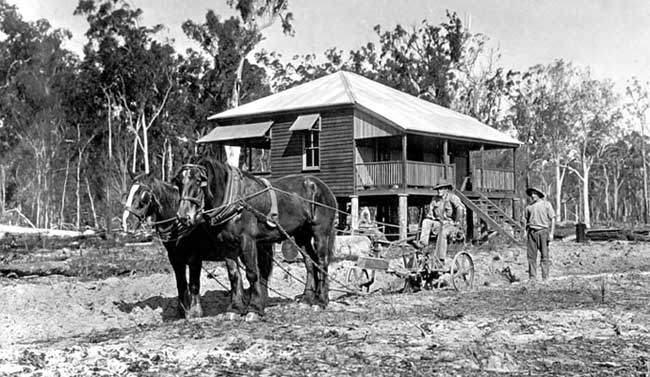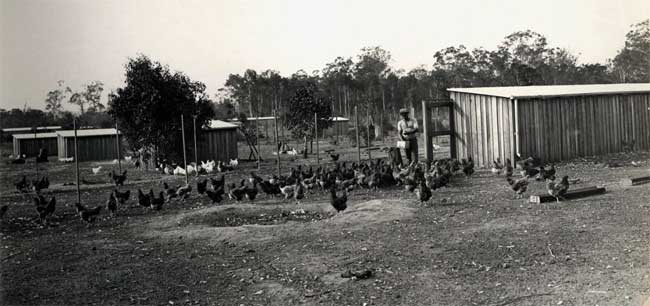The second dispossession of First Nations peoples in Australia
There must be thousands of reasons why many First Nations people haven't been able to live as comfortably in a 'white mans world' or establish themselves financially as well as their non-Indigenous counterparts, here is just one of those reasons.

Clearing of timber and soil preparation on Murray Valley Soldier Settlement blocks - Post WW2 Soldier settlement
When Australian soldiers returned from WW1 and WW2, they were able to apply through the Returned Servicemen's Settlement Scheme for small allotments of land provided by the government.
Even though Aboriginal people were legally excluded from serving in the armed forces, more than 300 to 400 Aboriginal servicemen served in the World War One, at Gallipoli and on the Western Front. However, on their return they resumed their inferior citizenship status.
In New South Wales (NSW) only one First Nations serviceman was successful in gaining a soldier settlement lot.
Six thousand, four hundred and forty eight non-Indigenous NSW men were successful in obtaining a farm and received help to make it a success. However, many of them cleared the land and for a mixed range of reasons, abandoned their farms. leaving the land in a such a derelict state it would probably take many years of sustainable land management practices to see some of these blocks return to the condition they were before the invasion. Most of the non-Aboriginal soldiers were from the city with no farming experiences and their families would move away the services they were accustomed to, such as shops, schools and medical services.
Although a few of the soldier settlers survived, the blocks were much more suitable for Aboriginal families who knew how to survive without all the trimmings of white society, and many of the Aboriginal men had considerable experience of working on Mission/Stations or as Labourer's at rural farms, one of the Mission/Stations in Victoria won first prize at the Melbourne International Exhibition in 1872 for the produce they grew*.
By 1924 WW1 Returned Soldiers and sailors had taken up settlement farms on 23,275,380 acres (94,192 km²) across Australia as per the following breakdown:
| State | Scheme commenced | Area allotted | Number of farms |
|---|---|---|---|
| South Australia | 1915 | 2,779,078 acres (11,247 km²) | 3,240 settlement farms |
| New South Wales | 1916 | 8,134,009 acres (32,917 km²) | 6,448 settlement farms |
| Queensland | 1916 | 705,565 acres (2,855 km²) | 2000 settlement farms |
| Victoria | 1917 | 2,290,489 acres (9,269 km²) | 8,640 settlement farms |
| Western Australia | 9,094,711 acres (36,804 km²) | 1,095 settlement farms | |
| Tasmania | 271,537 acres (1,098 km²) | 1,935 settlement farms |
Graph source: Wikipedia
Plagiarized land given to non-Indigenous returned soldiers
Some of the land provided for the Returned Servicemen's Settlement Scheme was Aboriginal reserves/missions land resumed by State Governments specifically for solder settlements blocks (small farms).
Successful First Nations farms were closed down
and the 'improved' land given to 'whites'

Enlarge
Corranderrk Award winning farm
land proved 'too fertile for blacks'

Enlarge
'Aboriginal Station' Victoria closed down
and the 'improved' pastoral land allocated
to 'white farmers'
Gradually, more and more government-run reserves were closed to meet increasing demands for land by white farmers. By 1913, 64 of the 97 Aboriginal reserves in South Australia had been leased or sold to white Australians.
In Victoria all reserves were leased or sold by the 1920s except one, Lake Tyers, where the land was so poor that white farmers didn't want it.
Independent reserve lands were also resumed. Almost half of all reserve land held by Aboriginal people in NSW in 1911 had been sold by 1927, and most of the remaining lands were then leased to white farmers. Much of it was fertile farmland which had been cleared and cultivated.
The loss of this land meant the loss of an economic base for many Aboriginal families. See: Coranderrk: First Nations Farmers and Market Gardeners
When governments resume property belonging to citizens they are obliged to pay compensation. No compensation was paid to Aboriginal people for the loss of their reserve land or for the improvements they had made, such as buildings, fencing, fruit trees and crops.
People who had lived independently for decades were left with nothing. There was no consideration by authorities for the difficulties Aboriginal people faced when they were evicted from reserves with no resources for re-establishment. In Aboriginal history this is known as the "second dispossession".
With no savings, little prospect of employment and no money for rent, evicted Aboriginal families built shelters on the fringes of towns. Without decent housing and services such as water and sewerage, authorities found it easy to remove Aboriginal children because they were "neglected".
It is not as if First Nations people could not farm, they have been nurturing the Australian landscape for many thousands of years but each time it was discovered that they could to be successful at "European style" farming they had the land taken from them, and were moved from the region pronto, with the land either given, leased or sold to 'White Australians' for farming purposes. There are recorded examples of this procedure in most states.
and free training programs

Returned soldiers ploughing, Beerburrum, July 1917 - Source: adoptadigger.org

Soldier settlement training 1918 - Beerburrum QLD

Soldier settlement training 1920 - Beerburrum QLD
One of the many farm/block training programs set up to assist white returned soldiers to establish themselves on the land - in a British perception.
From Sub committee minutes of the Queensland War Council established to assist in settling returned soldiers on the land
'... The intention of 'white soldier' settlement was to purchase land suitable for farming. Returned soldiers would be able to occupy and eventually obtain their title under a bond system. They would be assisted to equip the farms through the finance committee. The original members of the "Farms or Land Settlement Committee" were confirmed at the Council meeting on 18 October.
The Committee reported on 23 October 1916 that the buildings on the training farm had been erected and the first batch of returned soldiers wanting to settle on fruit lands were actively engaged on the settlement at Beerburrum.
At the Meeting of the War Council on 6 November 1916, the first allotment of land had been made that morning at Beerburrum in the presence of His Excellency and Lady Goold-Adams. By 9 July 1917 the Committee was able to report that 136 men had been placed on 52,630 acres of land, and that 291,127 acres had been set aside. As land was surveyed and settlements developed, numbers increased rapidly. At 3 January 1920 the Committee was able to report that 1,592 soldiers had selected 500,497 acres; 609 soldiers had been provided with homes; 18 were undergoing a course on training farms; 1,406 soldiers in addition to those on group settlements had received financial assistance to develop or purchase lands; and that group settlements were established at Beerburrum, Mount Gravatt, Enoggera, Pikedale, Stanthorpe, Mount Hutton, Cecil Plains, Ridgelands, Burrandowan and Atherton.
As soldier settlement increased, it was the Lands Department, under various Land Acts, including the "Discharged Soldiers' Settlement Act" of 1917, that processed land transactions ...'
Souce: QLD Government Archives
in New South Wales

A returned sercviceman's poultry farm, Bankstown Soldiers' Settlement Estate
Several different types of tenure were available under soldier settlement in New South Wales. These included Homestead Farm, Crown Lease, Returned Soldiers' Special Holding, Suburban Holdings, and Group Settlement Purchase.

Carting posts at Oban, New South Wales
at a returned servicemen settlement block
The terms and conditions for each type of land settlement were outlined in a government publication in 1918.
In April 1919 the Daily Telegraph reported that the New South Wales government had decided to implement a new idea in land development for ex-servicemen in order to avoid the failures of closer settlement schemes of the past. It believed group settlements had great potential for success because they offered help with practical training, and overcame problems of isolation.
Group settlements would be communities of ex-soldiers working cooperatively on small-scale farms with the guidance of a resident manager to help inexperienced or partially incapacitated men.
Bankstown Soldier Settlement was the first of these group settlements in the greater Sydney metropolitan area. In the County of Cumberland, there were six group purchase soldier settlements, mostly for poultry farming.
These settlements were at Bankstown, Grantham (Seven Hills), Campbelltown, Chipping Norton, Hillview (now Lurnea) and Doonside. More ...
Related Articles
 Coranderrk: First Nations Farmers and Market Gardeners
Coranderrk: First Nations Farmers and Market Gardeners
![]() Article *=Aboriginal Protection Board (Victoria)
Article *=Aboriginal Protection Board (Victoria)
 Coranderrk: We Will Show the Country
Coranderrk: We Will Show the Country

